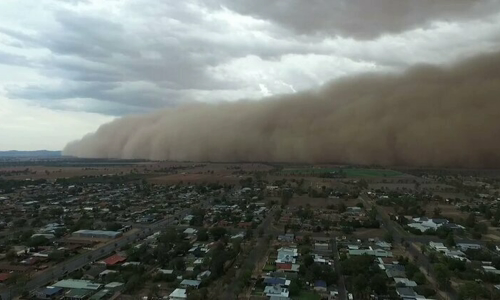A cloud of dust swept through the towns of New South Wales, obscuring the Sun and making the sky dark.
The Australian Meteorological Department issued many severe storm warnings last night, involving heavy dust clouds due to strong winds sweeping New South Wales, the southeastern state of the country.

A dust storm swept across the town of Narromine, New South Wales, southeastern Australia on January 19 Photo: Guardian
Videos and images posted by users on social networks show huge dust clouds millions of miles long, curled up and at least as tall as a 10-story building. Dust storms move quickly, engulfing the area in minutes and so dense that it obscures the sun.
Dubbo and Parkes residents described the sky as orange as the storm drew near but quickly became dark just minutes later when completely covering the town.
Dust storms are most likely caused by strong winds in the area. The Bureau of Meteorology recorded a gust of 94 km / h on the town of Parkes around 6:30 pm and another 107 km / h over Dubbo over an hour later.
The state of New South Wales has suffered from drought for many years, making the soil dry and fragmented, easily rising into the air when the wind is strong.
Heavy rains poured down on New South Wales on January 19 to ease drought and wildfires. Many coastal towns and river areas north of New South Wales recorded rainfall up to 100-180 mm from 9am to 10:30 pm last night.
Heavy rains in recent days have helped firefighters slow down the spread of wildfires in the state, and build defenses before the risk of wildfires increased again this week.
Rain and hail fell on Victoria state under severe weather conditions amidst continuing fires. The State Rescue Agency has received nearly 1,500 calls for help on the morning of January 19, including more than 1,000 damaged housing reports. Melbourne's east and northeast are hit by several strong storms, including hail.
Storm is expected to continue today. "We expect the storm to be active during the day, especially throughout southern New South Wales as well as the southwest," meteorologist Rose Barr said, adding that the storm is likely to move quickly. "extreme winds" and a possible hailstorm may occur.
Victoria still has about 14 fires. An emergency warning was issued on Tuesday evening about wildfires in central Victoria, but authorities lowered the alert to "follow up" earlier today.
Heavy rain can lead to flash floods in some areas, but the Bureau of Meteorology says it is difficult to extinguish all fires.
The wind will move in from the north and west in the middle of the week, bringing with it the drier, hotter air for two days 22-23 January. "That means both of these days we can see the risk of wildfires rising again, making it more difficult for the fire department," Barr predicted.



 TerriGuffeeHelton
TerriGuffeeHelton







